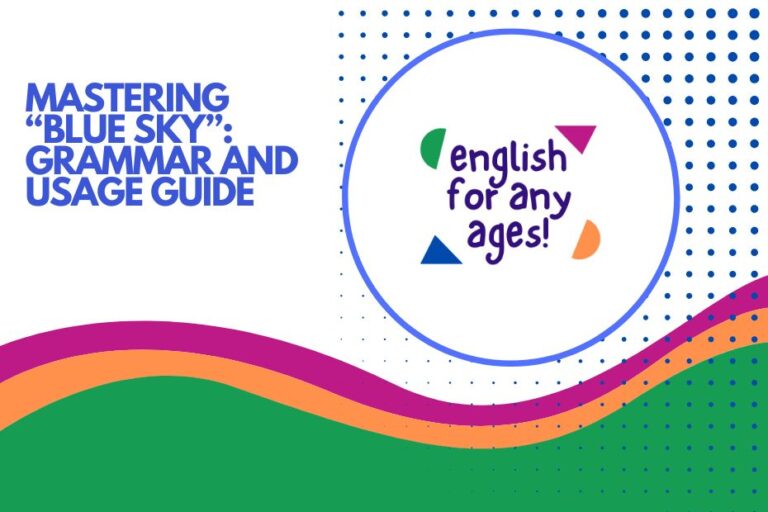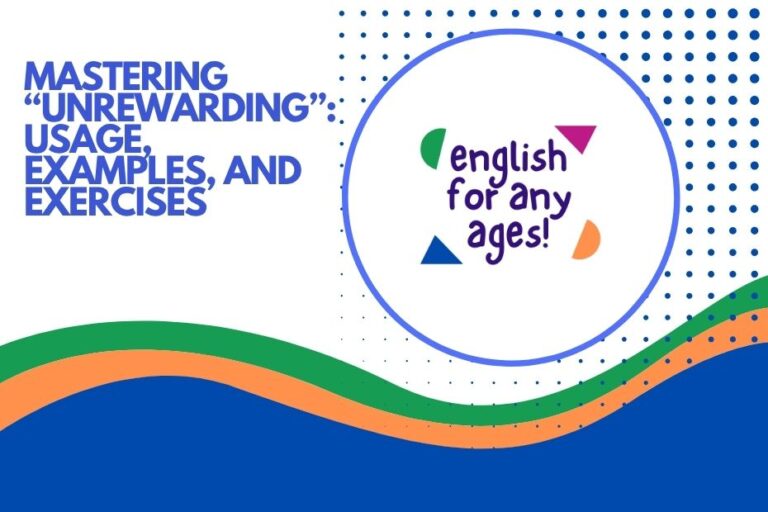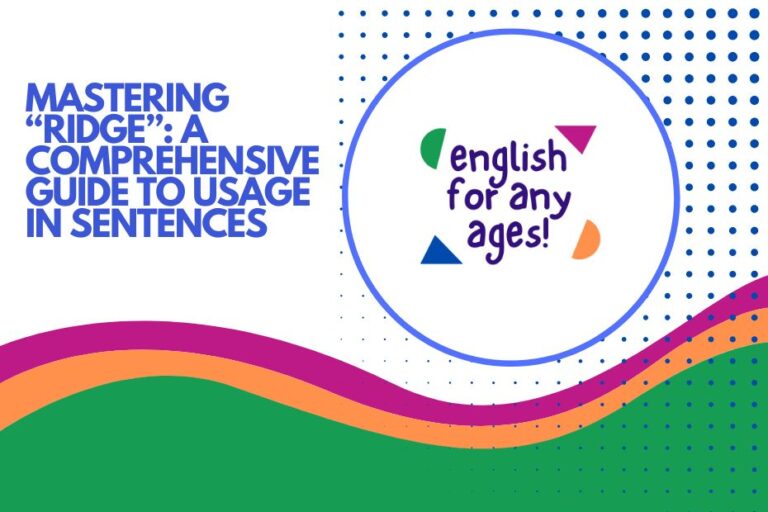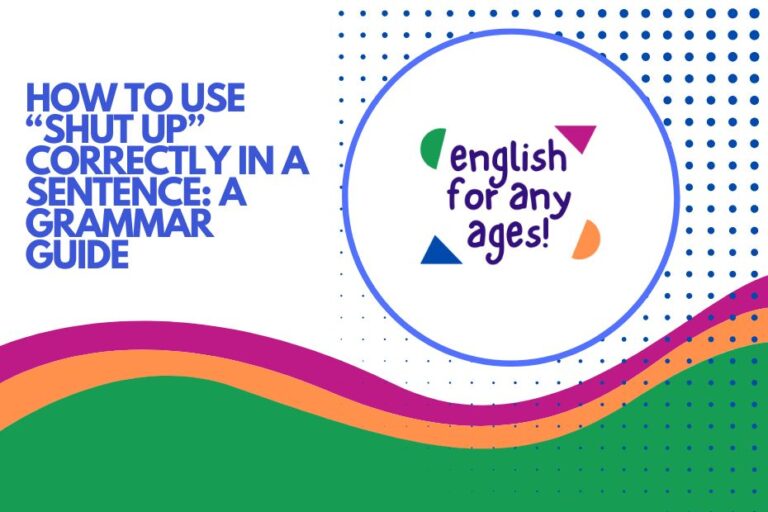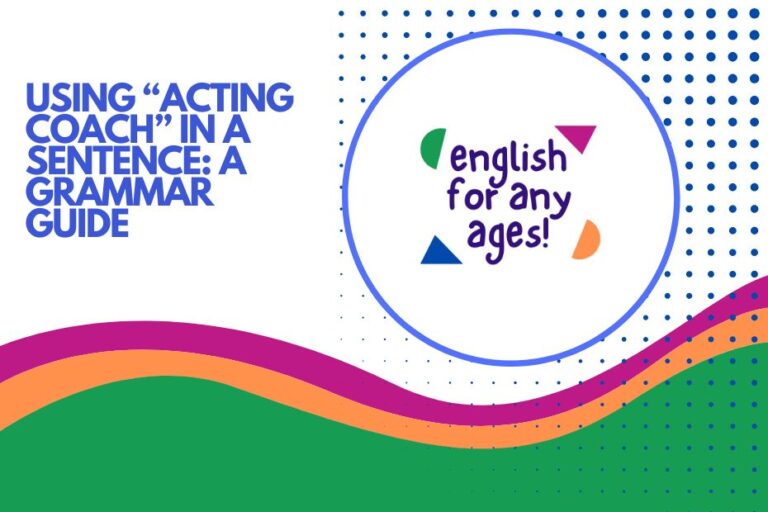How to Use “Break the Ice” in a Sentence: A Comprehensive Guide
The idiom “break the ice” is a common expression in the English language, used to describe the act of easing tension or awkwardness, especially at the beginning of a conversation or social situation. Mastering the usage of this idiom can significantly improve your communication skills and help you navigate social interactions more effectively.
This article provides a comprehensive guide on how to use “break the ice” correctly in a sentence, covering its definition, structural breakdown, usage rules, common mistakes, and practical examples. Whether you are a beginner or an advanced English learner, this guide will equip you with the knowledge and skills to confidently incorporate this idiom into your everyday conversations.
Table of Contents
- Definition of “Break the Ice”
- Structural Breakdown
- Types and Categories of Ice-Breaking Situations
- Examples of “Break the Ice” in Sentences
- Usage Rules
- Common Mistakes
- Practice Exercises
- Advanced Topics
- Frequently Asked Questions
- Conclusion
Definition of “Break the Ice”
The idiom “break the ice” means to say or do something to relieve tension or awkwardness, especially when people meet for the first time. It is typically used to create a more relaxed and friendly atmosphere. The phrase suggests that the initial situation is like a frozen surface that needs to be broken to allow for open communication and interaction. The idiom implies a transition from formality or discomfort to a more informal and comfortable setting.
In essence, breaking the ice involves initiating a conversation or activity that encourages people to feel more at ease and willing to engage with each other. This can be particularly important in professional settings, social gatherings, or any situation where establishing rapport is crucial.
The act of breaking the ice can pave the way for more meaningful connections and productive interactions.
Structural Breakdown
The phrase “break the ice” is typically used as a verb phrase within a sentence. It can be used in various tenses depending on the context.
The basic structure involves a subject performing the action of breaking the ice. Understanding the structural elements helps in using the idiom correctly and effectively.
The structure usually follows this pattern: Subject + Verb (break/broke/breaking/will break/etc.) + the ice (+ optional additional information). The subject is the person or group of people performing the action. The verb “break” can be conjugated into different tenses to indicate when the action occurred or will occur. “The ice” remains a constant part of the idiom. The optional additional information provides context or explains how the ice was broken.
Here are a few examples illustrating the structural breakdown:
- Present Simple: He breaks the ice with a joke.
- Past Simple: She broke the ice by asking about their weekend.
- Present Continuous: They are breaking the ice with a team-building activity.
- Future Simple: I will break the ice by introducing myself.
Types and Categories of Ice-Breaking Situations
Ice-breaking situations can vary depending on the context. Recognizing these categories helps in tailoring the approach to break the ice effectively.
Common categories include professional settings, social gatherings, and educational environments. Each setting requires a different strategy to ease tension and foster interaction.
Professional Settings
In professional environments, breaking the ice is often crucial for team building, networking, and client meetings. Examples include starting a meeting with a brief, lighthearted discussion, or using a team-building activity to encourage collaboration and communication among colleagues.
The goal is to create a comfortable atmosphere for productive discussions and decision-making.
Social Gatherings
Social gatherings such as parties, weddings, or casual meetups often require individuals to break the ice to initiate conversations and form connections. This can involve introducing oneself, asking open-ended questions, or commenting on the surroundings.
The aim is to ease the initial awkwardness and promote social interaction among attendees.
Educational Environments
In educational settings, breaking the ice is essential for creating a conducive learning environment. Teachers can use ice-breaking activities at the beginning of a semester or class to help students get to know each other and feel more comfortable participating.
This can include group games, introductions, or discussions about shared interests.
Examples of “Break the Ice” in Sentences
Understanding how to use “break the ice” in various contexts is crucial for effective communication. The following examples illustrate the idiom’s usage in different scenarios and tenses.
These examples are categorized to provide a clear understanding of its application.
Examples in Professional Settings
In a professional context, breaking the ice is important for creating a positive and collaborative environment. This table provides examples of how to use the idiom in different professional scenarios.
| Sentence | Context |
|---|---|
| “The team leader broke the ice by sharing a funny anecdote at the start of the meeting.” | Starting a team meeting |
| “To break the ice with the new client, I asked about their recent project successes.” | Meeting a new client |
| “We used a quick icebreaker game to break the ice during the workshop.” | Conducting a workshop |
| “She broke the ice at the conference by complimenting a speaker’s presentation.” | Networking at a conference |
| “The manager broke the ice by initiating a casual conversation about the weekend.” | Starting a performance review |
| “He always breaks the ice with a relevant joke before starting his presentation.” | Giving a presentation |
| “To break the ice during the training session, the facilitator used interactive exercises.” | Conducting a training session |
| “The CEO broke the ice by walking around and personally greeting each employee.” | Company-wide meeting |
| “Before diving into the agenda, let’s break the ice with a brief introduction round.” | Beginning a formal meeting |
| “She broke the ice by offering to help her new colleague with a task.” | Welcoming a new team member |
| “To break the ice, the HR department organized a team-building event.” | Organizing a team-building event |
| “He broke the ice during the negotiation by finding common ground on a minor issue.” | Negotiating a deal |
| “The project manager broke the ice by acknowledging the team’s hard work and dedication.” | Addressing a project team |
| “To break the ice at the convention, she joined a group discussing industry trends.” | Attending a convention |
| “The consultant broke the ice by asking about the company’s history and values.” | Consulting with a new company |
| “He broke the ice by sharing his personal experiences related to the topic.” | Leading a discussion panel |
| “To break the ice, the team decided to have a casual coffee break together.” | Team bonding activity |
| “She broke the ice by asking her boss about his weekend plans.” | Informal conversation with a superior |
| “To break the ice, the company hosted a welcome lunch for the new interns.” | Welcoming interns |
| “To break the ice, the new manager shared a bit about his background and interests.” | Introducing a new manager |
Examples in Social Gatherings
In social settings, breaking the ice is essential for making new friends and enjoying social events. This table illustrates how to use the idiom in various social scenarios.
| Sentence | Context |
|---|---|
| “He broke the ice at the party by asking if anyone had tried the appetizers.” | Attending a party |
| “To break the ice at the wedding, she complimented the bride’s dress.” | Attending a wedding |
| “She broke the ice by introducing herself at the networking event.” | Attending a networking event |
| “To break the ice, they started a conversation about their favorite movies.” | Meeting new people |
| “He broke the ice by offering to get everyone a drink.” | Socializing at a bar |
| “To break the ice at the book club, she shared her thoughts on the latest read.” | Attending a book club |
| “She broke the ice by asking her neighbor about their garden.” | Meeting a neighbor |
| “To break the ice, they played a game of charades at the family reunion.” | Attending a family reunion |
| “He broke the ice by asking about the other person’s hobbies.” | Starting a casual conversation |
| “To break the ice at the concert, she complimented the band’s performance.” | Attending a concert |
| “She broke the ice by offering a snack to the people sitting nearby.” | At a picnic |
| “To break the ice, they started discussing the local sports team’s performance.” | In a sports bar |
| “He broke the ice by asking if anyone needed help with directions.” | At a public event |
| “To break the ice at the art gallery, she commented on a particular painting.” | Visiting an art gallery |
| “She broke the ice by initiating a conversation about travel experiences.” | On a group tour |
| “To break the ice, they shared funny stories from their childhood.” | Meeting old friends |
| “He broke the ice by asking about the other person’s favorite type of music.” | At a music festival |
| “To break the ice, the host introduced everyone to each other.” | At a house party |
| “She broke the ice by complimenting someone’s pet at the dog park.” | At a dog park |
| “To break the ice, they started discussing their favorite books.” | Starting a conversation in a library |
Examples in Educational Environments
In educational contexts, breaking the ice is vital for creating a comfortable and engaging classroom environment. This table provides examples of how to use the idiom in various educational scenarios.
| Sentence | Context |
|---|---|
| “The teacher broke the ice by having students introduce themselves and share a fun fact.” | First day of class |
| “To break the ice during the workshop, the instructor used interactive group activities.” | Conducting a workshop |
| “She broke the ice by asking students about their interests related to the subject.” | Engaging students in a new topic |
| “To break the ice, the professor started the lecture with a relevant and humorous anecdote.” | Starting a lecture |
| “He broke the ice by organizing a team-building exercise for the students.” | Facilitating group work |
| “To break the ice at the seminar, the speaker asked participants to share their expectations.” | Starting a seminar |
| “She broke the ice by creating a collaborative brainstorming session.” | Encouraging participation |
| “To break the ice, the tutor used a fun game to teach grammar rules.” | Tutoring session |
| “He broke the ice by asking students about their weekend plans.” | Starting a casual classroom discussion |
| “To break the ice at the training session, the facilitator used a quick icebreaker question.” | Conducting a training session |
| “The professor broke the ice by sharing his personal experiences related to the course material.” | Connecting with students |
| “To break the ice, the students formed small groups to discuss their initial impressions of the course.” | Encouraging student interaction |
| “He broke the ice by starting the class with a thought-provoking question.” | Stimulating critical thinking |
| “To break the ice at the conference, the speaker used a lighthearted poll to gauge audience sentiment.” | Engaging the audience at a conference |
| “She broke the ice by organizing a student-led presentation on a relevant topic.” | Promoting student leadership |
| “To break the ice, the instructor used a visual aid to introduce the topic.” | Enhancing understanding |
| “He broke the ice by asking students to share their personal learning goals.” | Setting expectations |
| “To break the ice, the school organized a welcome event for new students.” | Integrating new students |
| “She broke the ice by creating a mentorship program for incoming students.” | Providing support |
| “To break the ice, the teacher used a short, engaging video to introduce the lesson.” | Using multimedia to engage students |
Usage Rules
Using the idiom “break the ice” correctly involves understanding its context and applying it appropriately. Here are some key rules to follow:
- Use in appropriate contexts: “Break the ice” is best used when there is a need to alleviate tension or awkwardness, especially at the beginning of an interaction.
- Choose the correct tense: Ensure the verb “break” is conjugated correctly to match the intended time frame. For example, use “broke” for past tense, “break” for present tense, and “will break” for future tense.
- Avoid overuse: While it’s a useful idiom, overusing it can make your language sound repetitive. Use it judiciously and consider alternative ways to initiate conversations.
- Consider cultural sensitivity: Be mindful of cultural differences. Some cultures may have different approaches to initiating conversations, and “breaking the ice” might not always be the most appropriate strategy.
Common Mistakes
Several common mistakes can occur when using the idiom “break the ice.” Recognizing these errors can help you avoid them and use the idiom correctly.
| Incorrect | Correct | Explanation |
|---|---|---|
| “I’m going to breaking the ice at the meeting.” | “I’m going to break the ice at the meeting.” | The correct form is “break the ice,” not “breaking the ice.” |
| “He brakes the ice with a joke.” | “He breaks the ice with a joke.” | The word “brakes” (related to stopping) is different from “breaks” (to separate or divide). |
| “She broken the ice at the party.” | “She broke the ice at the party.” | The past tense of “break” is “broke,” not “broken.” |
| “They tried to break an ice.” | “They tried to break the ice.” | The idiom uses the definite article “the,” not the indefinite article “an.” |
| “We will broke the ice later.” | “We will break the ice later.” | After “will,” use the base form of the verb “break,” not “broke.” |
| “Stop to break the ice all the time.” | “Stop breaking the ice all the time.” | In this context, “breaking” is a gerund acting as a noun. |
Practice Exercises
Test your understanding of “break the ice” with these practice exercises. Fill in the blanks with the correct form of the idiom.
Exercise 1
Complete the following sentences using the correct form of “break the ice.”
| Question | Answer |
|---|---|
| 1. To ________ at the conference, she introduced herself to the speaker. | break the ice |
| 2. He ________ by telling a funny story. | broke the ice |
| 3. They are planning to ________ with a team-building activity. | break the ice |
| 4. I will ________ by asking about their weekend. | break the ice |
| 5. She ________ at the meeting by sharing her experiences. | broke the ice |
| 6. To ________ at the party, he offered to get drinks for everyone. | break the ice |
| 7. The teacher ________ by starting the class with a fun question. | broke the ice |
| 8. They ________ with a casual conversation about the weather. | broke the ice |
| 9. We need to ________ before the presentation starts. | break the ice |
| 10. He ________ by complimenting her outfit. | broke the ice |
Exercise 2
Rewrite the following sentences using the idiom “break the ice” in a natural and appropriate way.
| Original Sentence | Rewritten Sentence |
|---|---|
| 1. He tried to make the atmosphere less tense by telling a joke. | He tried to break the ice by telling a joke. |
| 2. She wanted to start a conversation at the party. | She wanted to break the ice at the party. |
| 3. The teacher began the class with an engaging activity. | The teacher broke the ice by starting the class with an engaging activity. |
| 4. They decided to do something to ease the awkwardness. | They decided to break the ice. |
| 5. I will try to initiate a friendly conversation. | I will try to break the ice. |
| 6. She made the situation less formal by sharing a personal story. | She broke the ice by sharing a personal story. |
| 7. To start the meeting on a positive note, he told an anecdote. | To break the ice, he told an anecdote at the start of the meeting. |
| 8. They found a way to make everyone feel more comfortable. | They found a way to break the ice. |
| 9. He was trying to create a more relaxed environment. | He was trying to break the ice. |
| 10. She introduced a game to make everyone feel at ease. | She broke the ice by introducing a game. |
Advanced Topics
For advanced learners, understanding the nuances and subtle variations of the idiom “break the ice” can further enhance communication skills. This includes exploring alternative idioms with similar meanings and recognizing the cultural context in which the idiom is used.
Alternative Idioms: Several other idioms convey similar meanings to “break the ice.” These include “get the ball rolling,” “warm up,” and “get acquainted.” Understanding these alternatives can add variety to your language and allow you to express similar ideas in different ways.
Cultural Context: The act of breaking the ice can vary significantly across cultures. In some cultures, direct and assertive approaches are common, while in others, more subtle and indirect methods are preferred. Being aware of these cultural differences is crucial for effective cross-cultural communication.
Frequently Asked Questions
Here are some frequently asked questions about using the idiom “break the ice” in a sentence.
- What does “break the ice” mean?
“Break the ice” means to say or do something to relieve tension or awkwardness, especially when people meet for the first time. It’s about creating a more relaxed and friendly atmosphere to encourage open communication and interaction.
- How do I use “break the ice” in a sentence?
You can use it as a verb phrase. For example, “He broke the ice by telling a joke.” The key is to use the correct tense of the verb “break” (break, broke, breaking, will break, etc.) depending on the context.
- Is it appropriate to use “break the ice” in all situations?
While it’s generally a useful idiom, it’s not always appropriate. Consider the cultural context and the specific situation. In some formal settings, a more direct approach might be preferable. Avoid using it excessively to prevent your language from sounding repetitive.
- What are some common mistakes when using “break the ice”?
Common mistakes include using the wrong tense of the verb “break” (e.g., “broken” instead of “broke”), confusing it with “brakes,” or using the wrong article (e.g., “break an ice” instead of “break the ice”).
- Can you give me some examples of how to break the ice in a professional setting?
In a professional setting, you can break the ice by starting a meeting with a brief, lighthearted discussion, asking about a client’s recent project successes, or using a quick icebreaker game to encourage collaboration among colleagues.
- How can I break the ice at a social gathering?
At a social gathering, you can break the ice by introducing yourself, asking open-ended questions, complimenting someone’s outfit, or commenting on the surroundings. The goal is to initiate a conversation and make others feel comfortable.
- Are there any alternative idioms to “break the ice”?
Yes, several idioms convey similar meanings, such as “get the ball rolling,” “warm up,” and “get acquainted.” These alternatives can add variety to your language and allow you to express similar ideas in different ways.
- How can I improve my ability to break the ice in different situations?
Practice is key. Observe how others initiate conversations and try different approaches yourself. Be mindful of your audience and adapt your strategy accordingly. Pay attention to nonverbal cues and adjust your approach as needed.
Conclusion
Understanding and effectively using the idiom “break the ice” is a valuable skill for anyone looking to improve their communication and social interactions. This article has provided a comprehensive guide, covering its definition, structural breakdown, usage rules, common mistakes, and practical examples in various settings.
By mastering this idiom, you can confidently navigate social and professional situations, creating a more relaxed and positive atmosphere for everyone involved.
Remember to practice using “break the ice” in your daily conversations and be mindful of the context and cultural nuances. With consistent effort, you can enhance your communication skills and build stronger connections with others.
Keep exploring new ways to initiate conversations and make people feel at ease, and you’ll find that “breaking the ice” becomes a natural and effective part of your communication style.

